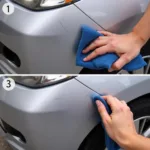Repairing car body paint is a common concern for car owners. Whether it’s a minor scratch, a deep gouge, or fading paint, restoring your car’s finish can significantly enhance its appearance and value. This guide provides a comprehensive overview of car body paint repair, from DIY fixes to professional solutions.
One of the first things to consider when approaching a car paint repair is the extent of the damage. For minor scratches, a simple car scratch remover kit might suffice. For more extensive damage, like dents and deep scratches, professional intervention may be required. Understanding the different repair options will help you choose the most effective and cost-efficient solution. See our guide on the Dupli-Color Body Paint Repair Kit Car Scratch Remover for more information on DIY scratch repair.
Assessing the Damage: Knowing Your Repair Options
Before you begin any repair, assess the damage to determine the appropriate course of action. This includes identifying the type of damage (scratch, chip, dent, etc.), the depth of the damage (clear coat, paint, primer, metal), and the extent of the affected area.
Minor Scratches and Chips
Minor scratches that only affect the clear coat can often be addressed with a polishing compound or a specialized scratch remover. Chips, on the other hand, might require touch-up paint and a clear coat application.
Deep Scratches and Gouges
Deep scratches that penetrate the paint layer and reach the primer or metal require more extensive repair. This might involve sanding, filling, priming, and repainting the affected area.
Dents and Bodywork Damage
Dents and bodywork damage often require professional repair. A body shop can repair the dent, fill any imperfections, and repaint the area to match the original car color.
Fading and Oxidation
Fading and oxidation, common in older cars, can be addressed through compounding, polishing, and waxing. In severe cases, a complete repaint might be necessary to restore the car’s original shine.
You can find more information about rust repair and paint jobs at car body rust repair and paint. This guide provides valuable insights into addressing rust, a common issue that can often complicate paint repair.
DIY vs. Professional Repair: Making the Right Choice
Choosing between DIY and professional repair depends on the severity of the damage, your skill level, and your budget.
DIY Repair: A Cost-Effective Solution for Minor Damage
DIY repairs are ideal for minor scratches, chips, and fading. Numerous repair kits and products are available on the market that cater to beginners. However, attempting DIY repairs on significant damage might exacerbate the problem and ultimately cost more in the long run.
Professional Repair: Expertise for Complex Damage
Professional repair is recommended for dents, deep scratches, and extensive bodywork damage. Body shops have the expertise, tools, and equipment to ensure a high-quality repair that restores your car’s finish to its original condition. Learn more about a specific repair shop in our article about Paint Tech Car Body Repair Abingdon.
Tips for a Successful Car Body Paint Repair
Regardless of whether you choose DIY or professional repair, following these tips can help ensure a successful outcome:
- Clean the Area: Thoroughly clean the affected area to remove dirt, debris, and wax before starting any repair.
- Use the Right Products: Choose high-quality products specifically designed for car paint repair.
- Follow Instructions Carefully: Carefully follow the instructions provided with the repair kit or by the professional.
- Be Patient: Car paint repair can be time-consuming. Take your time and avoid rushing the process.
- Protect Yourself: Wear appropriate safety gear, such as gloves and a mask, when working with chemicals and sanding materials.
For those interested in gaming and car customization, check out Jurassic Park World Xbox One Paint Body Repair Cars.
Conclusion: Restoring Your Car’s Finish
Repairing car body paint can significantly improve your car’s appearance and value. By understanding the different repair options and following the proper techniques, you can effectively address paint damage and restore your car’s finish to its former glory. Remember to carefully assess the damage before starting any repair and choose the approach that best suits your needs and budget. For more information, explore the resources available on Acts Body Paint and Car Repair.
FAQ
- How much does it cost to repair car body paint? The cost varies depending on the extent of the damage and the chosen repair method.
- Can I repair car body paint myself? Yes, minor scratches and chips can often be repaired with DIY kits.
- What type of paint should I use for car body repair? Use automotive paint specifically designed for your car’s make and model.
- How long does it take for car paint to dry? Drying times vary depending on the type of paint and environmental conditions.
- How can I prevent car body paint damage? Regular washing and waxing can help protect your car’s paint.
- What are the different types of car paint repair methods? Common methods include touch-up paint, scratch removers, and professional repainting.
- Where can I find professional car body paint repair services? Local body shops and dealerships offer professional repair services.
Need more help? Contact us via WhatsApp: +1(641)206-8880 or Email: [email protected]. Our customer service team is available 24/7.


